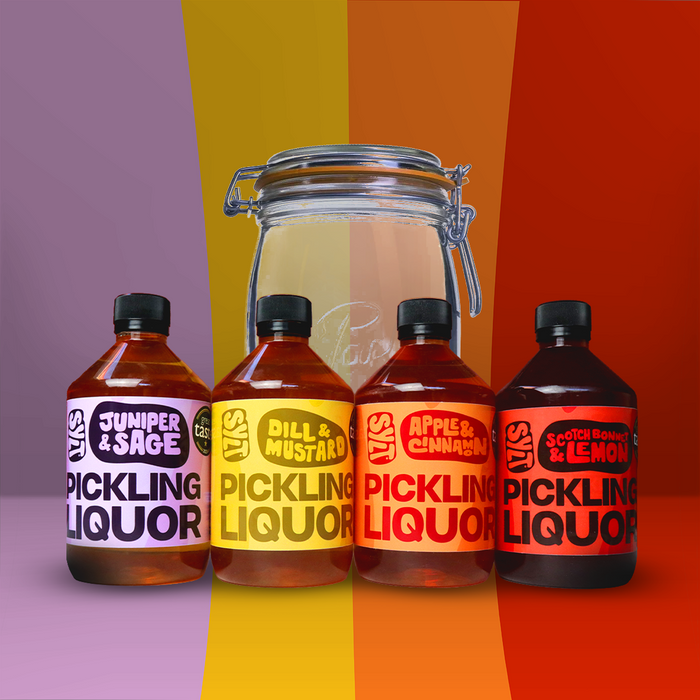· By Aslak Ringhus
Pickling through the seasons
Why are we so obsessed with pickling? Well, it's one of the only culinary practices that transcends seasons. So if you pickle your veggies, you can enjoy them whatever the weather.
We all know that pickles bring the flavour to the table, but they also extend the shelf life of your veggies. Need we say more?
Come on a journey with us through the seasons and learn how to transform you seasonal produce into delicious, tangy treats. And get ready to stock up your pantry with vibrant jars of pickled delights. Let's go.
Spring: A season of awakening
Think Spring. Think tender, crisp veggies. As the earth thaws and sprouts begin to peek, keep your eyes out for freshest pickling subjects of the year. Radishes, with their peppery bite, are ideal for quick pickling, adding a colourful zing to salads and sandwiches. Spring onions and young garlic offer a milder alternative to their mature counterparts, perfect for adding a nuanced depth to dishes. Asparagus, another spring favourite, pickles beautifully, maintaining its crispness and green hue, making it a delightful addition to charcuterie boards or a solo snack. Any of the above are sure to put a spring in your step.
Spring: radishes, spring onions, garlic, asparagus
Summer: The bounty of warmth
It's all about the colour. Vibrant and robust flavours thrive under the sun's nurturing warmth. First off, cucumbers provide the quintessential pickle. Whether you prefer crunchy dill pickles or sweet gherkins. Bell peppers - whatever your colour choice - can be pickled whole or sliced, adding a sweet and tangy crunch to dishes. Courgettes and summer squash are also perfect candidates for a tangy summer pickle. But don’t forget about green beans and okra, they keep their crunch. Satisfaction rating: 100.
Summer: cucumber, bell peppers, courgettes, squash, green beans, okra
Autumn: Harvest’s rich palette
As the leaves change colour, so does the seasonal veggies. Autumn’s harvest brings a richness in flavours and textures. Carrots, with their natural sweetness, become delightful when pickled, perfect for adding to salads or serving as a side. Beets, with their earthy flavour and deep crimson colour, are not only nutritious but also turn the pickling brine a stunning magenta, making for visually striking preserves. Cauliflower breaks away from its bland stereotype when pickled, absorbing spices and seasonings beautifully, making it a versatile pickled vegetable to have on hand. Brussels sprouts, they aren’t just for Christmas, another fall vegetable that offers a unique option for pickling, with their layers soaking up the brine, turning into a must-try delicacy for the adventurous palate.
Winter: Embracing the cold
Winter’s chill brings about a selection of hardy vegetables that stand up well to the pickling process. Cabbage, traditionally it’s the base ingredient for transformation into sauerkraut or kimchi but it makes for a fantastic pickle too and is a winter staple, rich in vitamins and probiotics. Turnips and Swedes, often underappreciated, become tangy and flavourful when pickled, making them a great addition to meals for a burst of flavour. Kohlrabi, with its crisp texture and sweet, slightly spicy flavour, is another excellent choice for pickling during the colder months, offering a refreshing contrast to heavier winter dishes.
Year-Round Vegetables for Pickling
Some vegetables are versatile enough to be found throughout the year, making them staples in the pickler's pantry. Onions, with their sharpness, mellow out beautifully when pickled, becoming a fantastic topping for a variety of dishes. Garlic, pickled in its cloves, is a wonderful way to add a milder, sweeter garlic flavour to dishes or to be enjoyed on its own. Chilies, varying in heat levels, can be pickled to add spice and zest to any meal, customizable to your heat preference.
Tips for Seasonal Pickling
- Experiment with Different Pickling Liquids: Sylt curate a great range on pickling liquids ranging from mellow herbed flavours and rich balsamics through to rich spicings. There will be a perfect blend for you.
- Incorporate Herbs and Spices: Each vegetable pairs well with different herbs and spices. Dill, mustard seeds, and coriander are amongst our classics, but don't be afraid to experiment by adding other twists like turmeric, cinnamon, or bay leaves. If you do come up with your own classic interpretation then please get in touch to let us know.
- Use Fresh, Seasonal Produce: For the best flavour and texture, pick vegetables that are in season and at their peak of freshness.
- Always think “Hygiene”: It goes without saying but we always re-iterate it. Sterilise your jars by washing them with hot, soapy water then rinsing thoroughly.
Ultimately pickling is a wonderful way to capture the essence of each season, allowing us to preserve the abundance of the harvest and enjoy it throughout the year. Whether you’re a seasoned pickler or new to the craft, the variety of vegetables available across the seasons offers endless possibilities for creativity and flavour. By selecting
seasonal produce for pickling, you not only enjoy the freshest flavours but also support sustainable eating practices. So, the next time you find yourself with a bounty of seasonal vegetables, consider pickling them. Not only will you extend their shelf life, but you'll also unlock a whole new world of flavours and textures to enjoy throughout the year.



